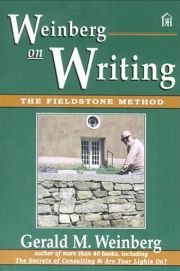Gerald M. Weinberg has written dozens of books and hundreds of articles on computers, technology, consulting, and the craft of composition. Weinberg on Writing: The Fieldstone Method is an excellent survey of the methods he has used in order to produce this voluminous output. The comprehensive table of contents provides the reader with a clear, useful map of what lies ahead, and the exercises sprinkled throughout this short, readable book make it a valuable addition to any writer’s bookshelf.
There is a double benefit to taking this kind of risk. First, we get to change the boring and uninspiring into the exciting and meaningful by applying a little creativity. Second, we can separate ourselves from the crowd by turning in something important rather than something that is simply “assigned.” 2. You need to collect stones before you can build. In other words, you need something to write about before you can start writing. Most of these stones will be useful in one project or another: as Weinberg notes (p. 15), for people who are working on multiple projects at any given time, gathering stones and putting them in appropriate project-specific piles brings us closer to completion. This can also be dangerous, though, because gathering stones can be a kind of unproductive procrastination. Balance is the key, and you should work on projects with an eye toward completion rather than mere accumulation. 3. How we react to the ideas we have is what is important (pp. 18-21). It isn’t that we have too many ideas, or even usually too few. Organizing the ideas we do have (when we have too many) and finding new ideas (when we have too few) helps us break through “writer’s block.” If we aren’t sure what to do with the ideas once we have them, we can start relating to them by writing “blah blah blah blah…” or “X X X X…” until we decide to start writing something else (p. 128). A key to writing is to overcome the fear of engaging with our ideas. 4. Be an alert intellectual entrepreneur. Weinberg “cannot take a trip anywhere–in real space or virtual space–without coming home with a collection of ‘stones.’” Ideas are out there–we have to be on the lookout for them, and most of the work of gathering those ideas will be done incrementally. 5. Learn by copying. Hunter S. Thompson used to re-type the work of Hemingway in order to get a feel for great writing. Weinberg suggests doing something similar: copy samples of what we think of as great writing, and then reflect on the process. Over time, we develop a better feel for good and bad writing. 6. Practice continuous capture. Being a fieldstone writer, according to Weinberg, is about constantly having the resources needed to capture ideas. There are obvious parallels between Weinberg’s fieldstone method and the “collect” and “organize” components of David Allen’s popular Getting Things Done methodology. Where Allen discusses these activities in the abstract, Weinberg offers concrete examples in the context of a very specific task: writing. 7. Recycle. Weinberg devotes a lot of space to borrowing and stealing from both fiction and non-fiction and argues that both can be done very effectively. Imitation is bad style, but a writer who steals from and improves on others’ work is advancing the craft (astute readers will note that I stole this from T.S. Eliot). 8. If you’re passionate about writing, don’t skimp on capital (chapter 7). Just because something is expensive doesn’t mean it’s a bad investment if it really improves your writing. Over the summer, I bought a MacBook Air that goes with me virtually everywhere and that is ridiculously easy to use. It wasn’t cheap, but it has improved my productivity. 9. Just get it on paper already. It won’t be perfect. Nothing is, and nothing ever will be. However, an idea that is written down is much closer to perfection–or at least completion–than one that isn’t. 10. Be merciless with revisions and criticism, but know when to stop. On one hand, you should make every word prove itself. If there is any doubt whether it should be invited to the party, remove it. On the other hand, it is easy to turn this into an unhealthy obsession. Compare marginal costs and marginal benefits: if the marginal cost of one more revision is higher than the marginal benefit, then it’s good enough. I have heard it said that the best way to learn to write well is to begin by writing poorly. Just as one can’t learn to run marathons by reading about it or by watching runners on TV, one cannot become a writer by reading about writing or by watching other people write. This might help, but the process of composition is a process of exploration and experimentation where the efficacy of a given phrase, sentence, paragraph, or chapter may not become apparent until after it has been written. The method described by Weinberg brings this into high relief through an arresting metaphor and the use of clear principles, and the principles he discusses will prove a worthy addition to the writer’s toolkit.

